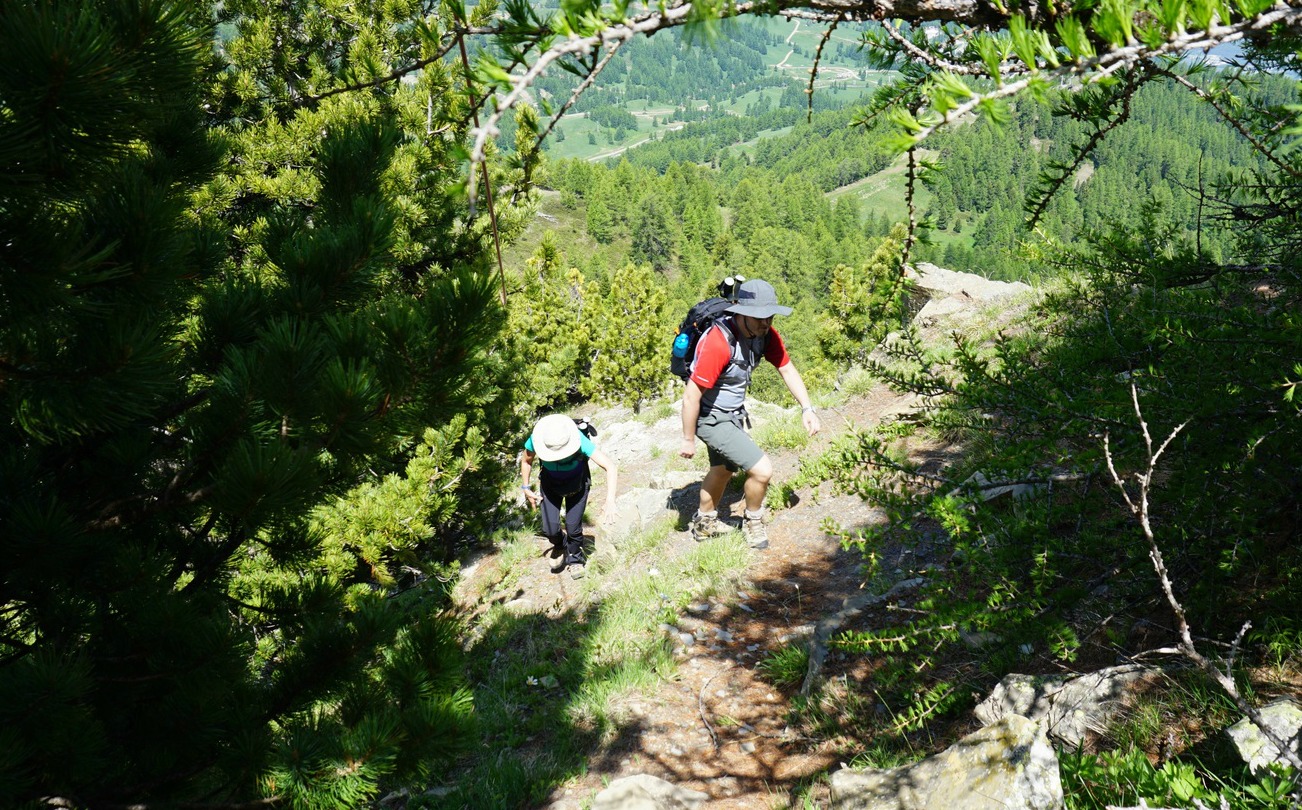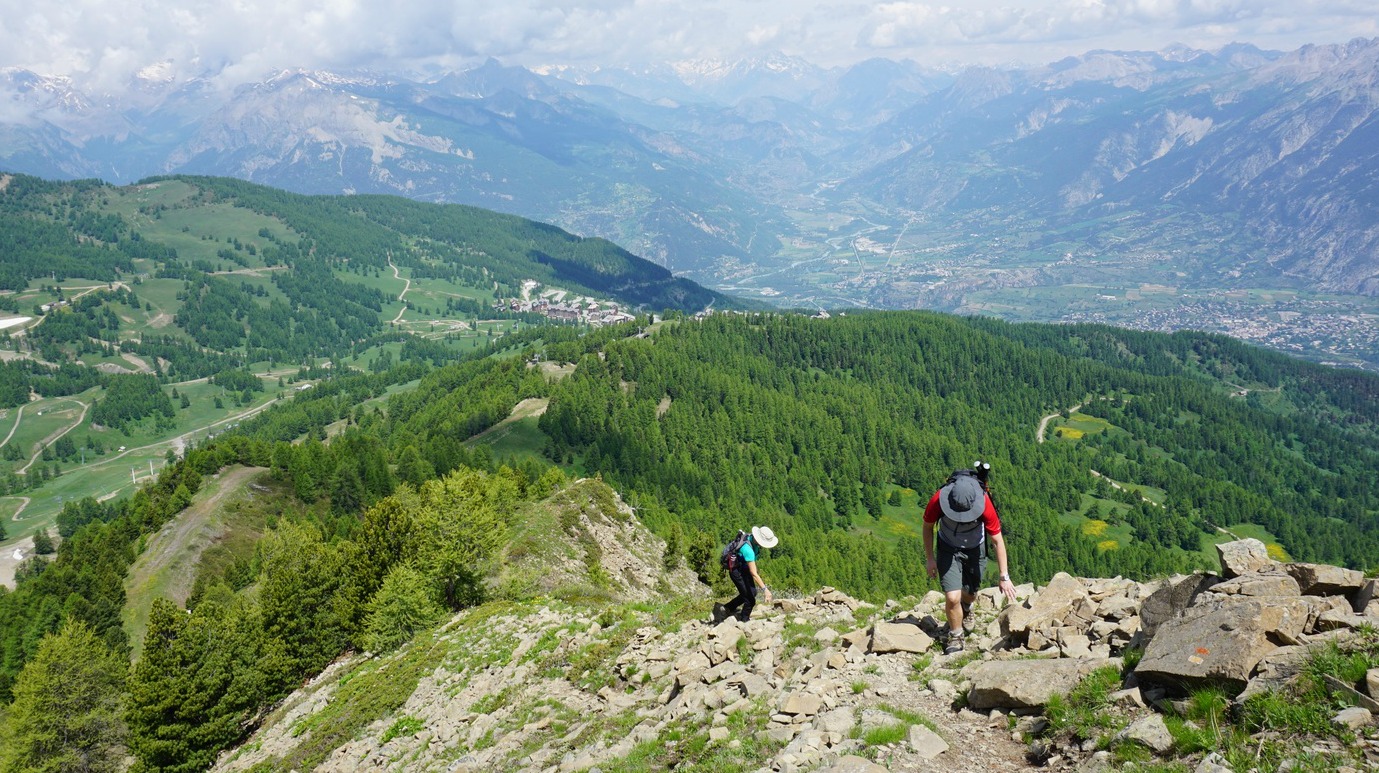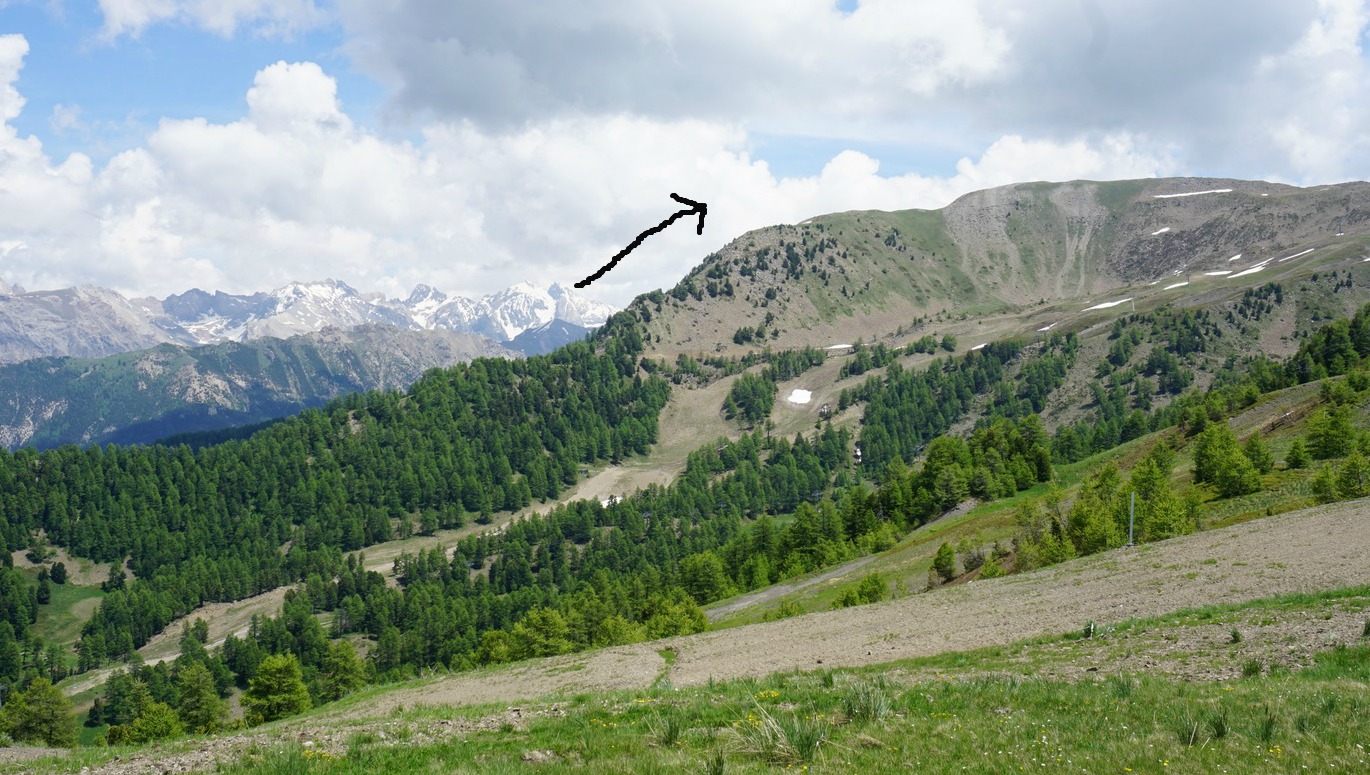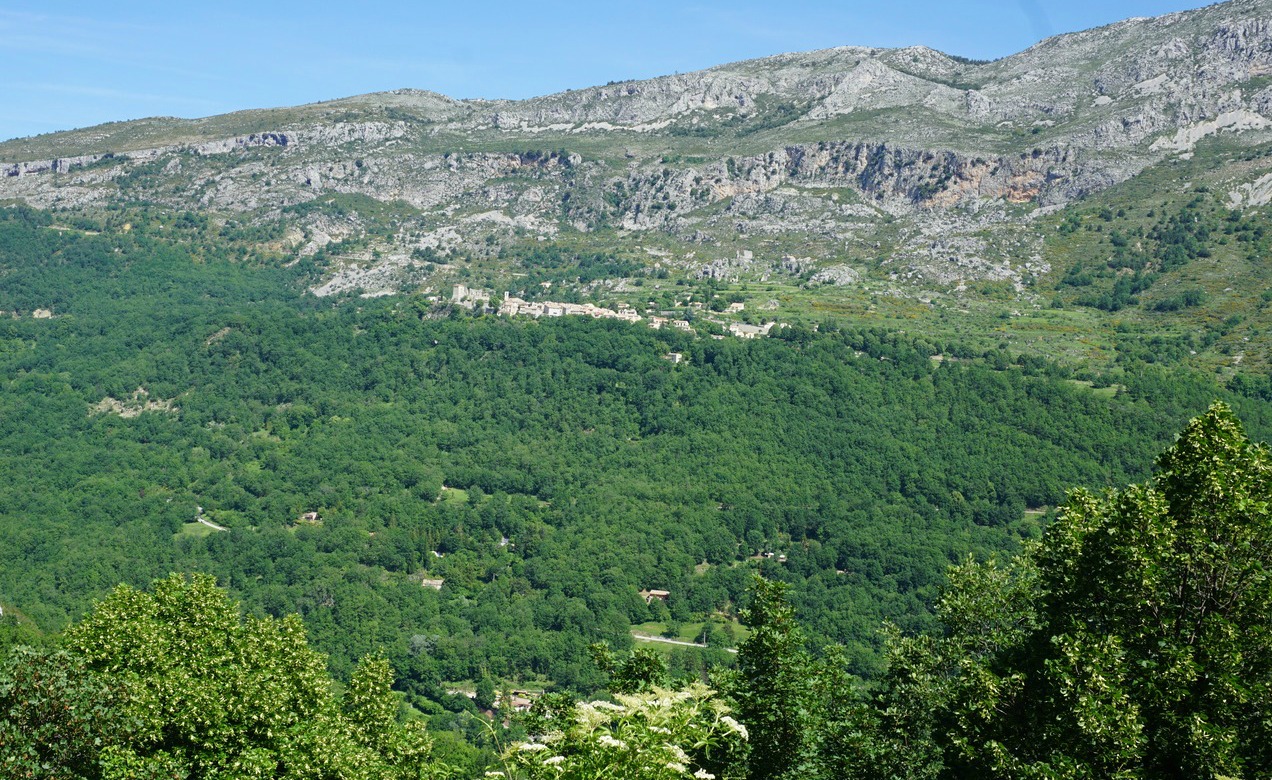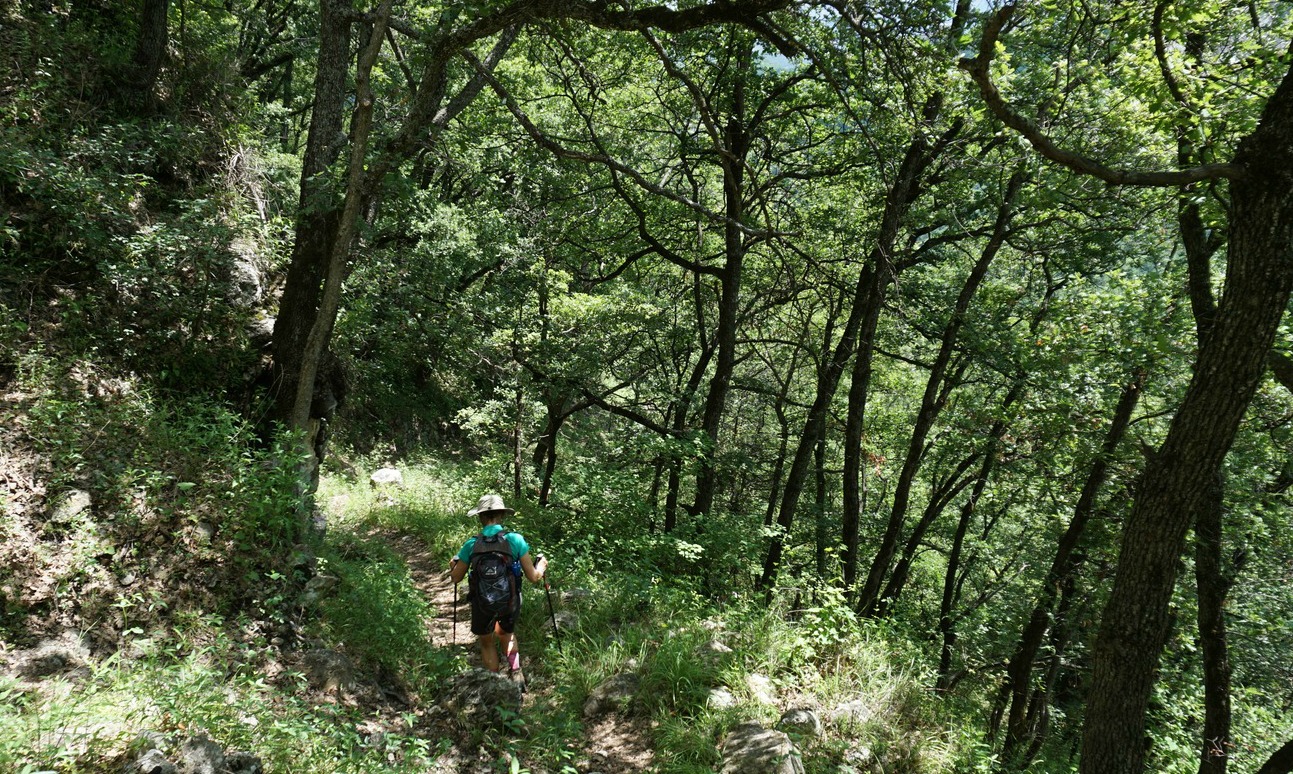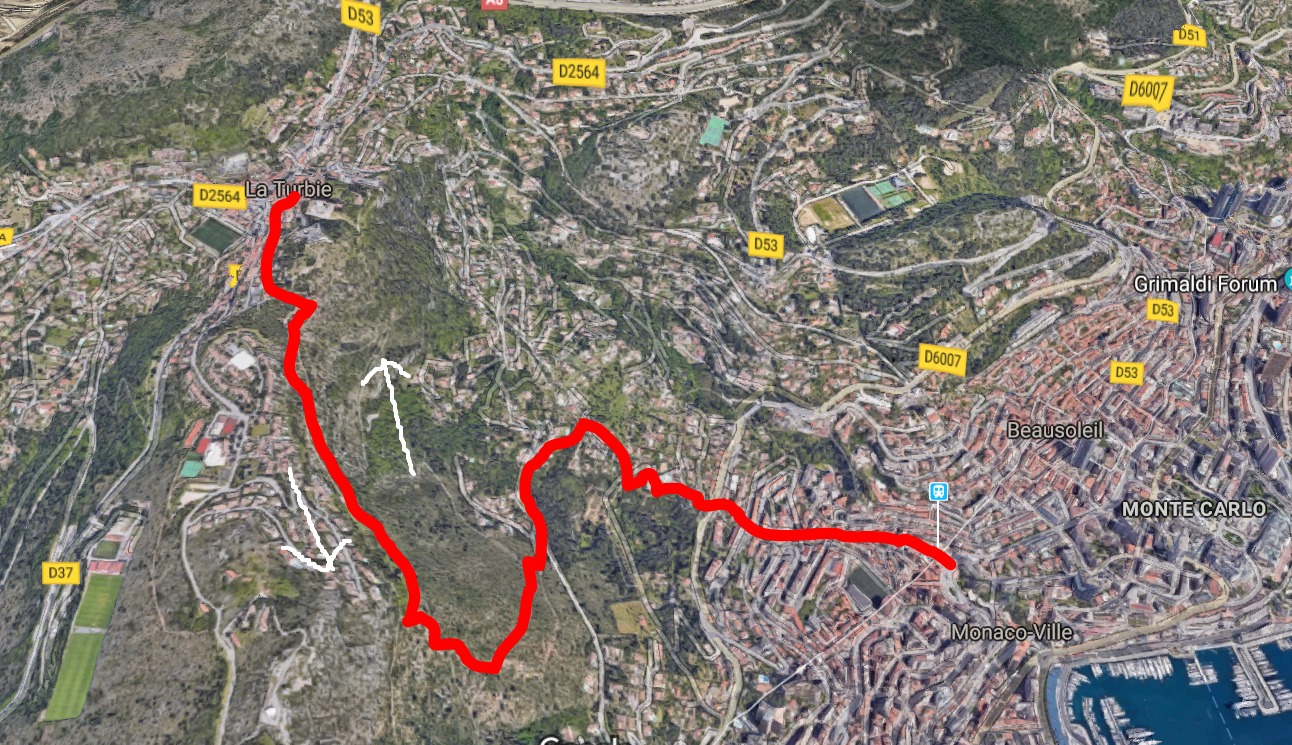

The following recipe has typical Mediterranean ingredients: olive oil, red mullet, fennel, black olives, cherry tomatoes, garlic, and saffron. If you cannot find red mullet in your area, you could replace it with bream or some other firm- fleshed white fish.
I prefer to bake red mullet fillets in oven. They only need to be brushed with olive oil before baking, there is no need to add any salt because black olives contain enough salt. As the red mullet fillets in our supermarket in Nice are quite small, they only need to be baked for about 7- 8 minutes in 200° C.
2 servings
About 250- 300 g red mullet fillets
1 fennel
1 shallot, minced
1 clove garlic, minced
5- 7 new potatoes
About 10 cherry tomatoes
2 tbsp. pitted black olives
Olive oil
Freshly ground black pepper
1/3 tsp. saffron powder
Dill
Lemon wedges
Wash the potatoes and cut them into thick slices. Microwave with some water for about 5- 6 minutes until soft. Spread the slices on kitchen paper to dry.
Wash the fennel and cut into thick wedges. Microwave with a little water for about 5 minutes until soft, then let dry on kitchen paper.
Warm 3 tbsp. olive oil in a large frying pan over medium heat. Add the minced shallot and garlic and sauté for about 5 minutes. Add the potatoes, fennel, cherry tomatoes, and black olives. Sprinkle the saffron over the vegetables and mix gently. Grind over some black pepper, cover, and reduce the heat. Let simmer.
Meanwhile bake the red mullet fillets. Spread the fillets on an oven tray covered with baking paper. Brush them with olive oil and bake for 7- 8 minutes.
Divide the vegetables on the plates and place the fish on top. Decorate with dill and serve with lemon wedges.

Risoul (1850 m) in the Southern French Alps is a ski resort connecting with the neighbouring resort of Vars. To reach it by car, however, you have to drive down from Vars to Guillestre to take the good road up to Risoul.
In summer, in spite of numerous ski lifts and runs, Risoul offers some great hikes. We chose to do part of the loop trail called Le Grand Panorama. This was in mid-June and the resort was completely closed and deserted. We only met a couple of other hikers on the trails.
Above the Risoul Tourist Office, at the front de neige with several ski lifts, we started along a dirt track by Les Melezes ski lift. After 200 m or so we came to a signpost showing the direction of our planned itinerary to Sommet de Razis along Le Grand Panorama trail (yellow marks). We forked left, heading east, along a wider dirt track in a magnificent forest. At the next sign, we turned right, now heading south, starting to climb more steeply. We crossed some ski runs, while most of the time zigzagging in the woods along Crête de Mélézet. Leaving the ski area, the trail continued even more steeply along Crête de Razis, eventually above the tree line. Some easy scrambling was needed in places.
Approaching the summit, the trail levelled off. There were some patches of snow here and there. We first walked past a wooden cross, and saw the highest point marked with a cairn and a sign not far away. It took us about 2,5 hours from the village.
We continued along the marked trail passing Risoul’s highest ski lifts, before descending towards Col de Valbelle. Because the alpine meadows were still quite wet, and there was lingering snow in some spots, we opted to descend mostly along small dirt roads winding down to the village. The views were superb also during the descent.
Hiking time: 4h 30
Climb: 736 m
Length: 13,7 km
Map: IGN 3537 ET Guillestre Vars Risoul
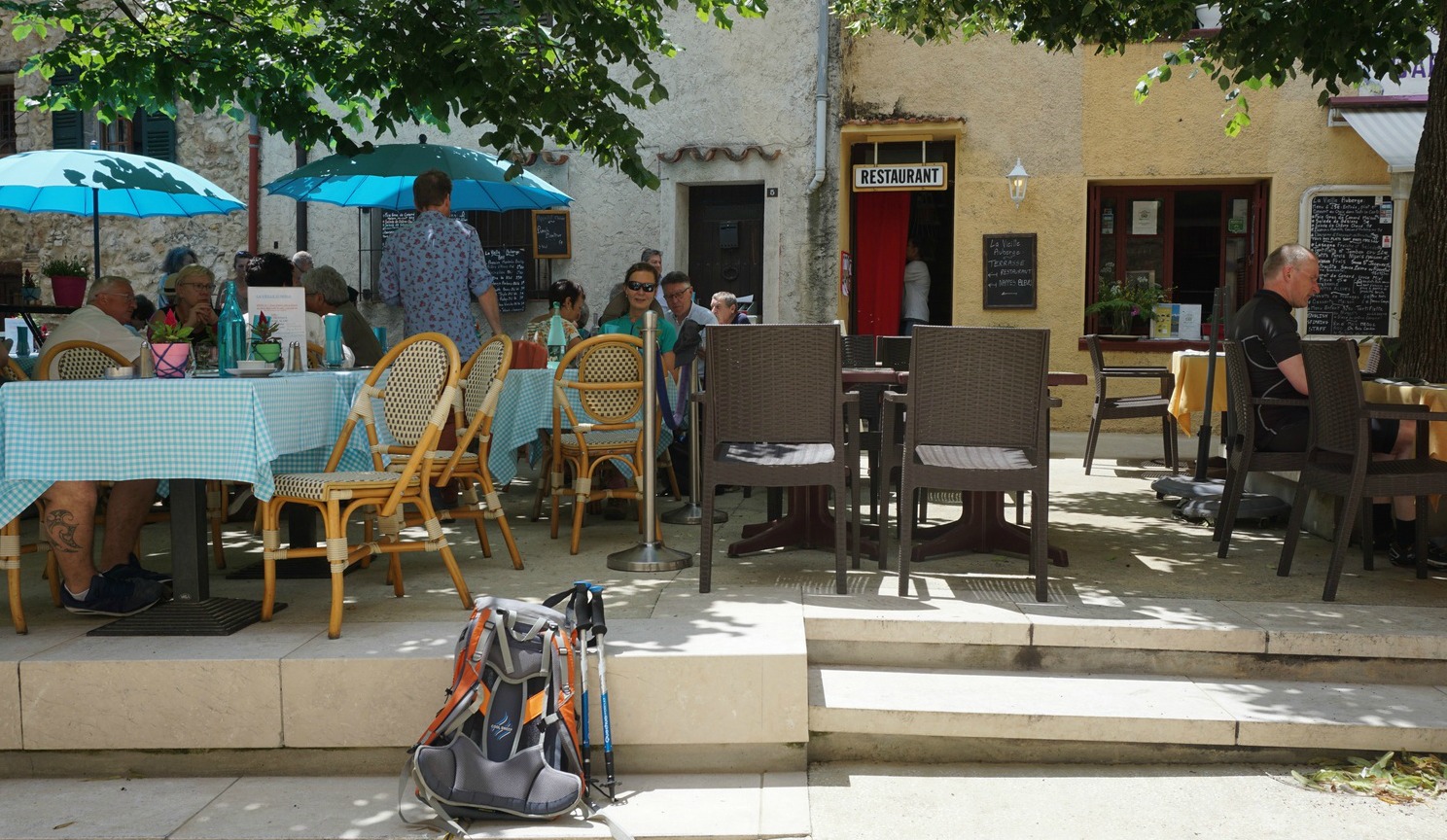
Cipières (750 m) and Gréolières (830 m) are two villages in Moyen Pays facing each other over the River Loup. Gréolières is nowadays a popular lunch stop among cyclists and hikers and has good restaurants. Cipières is these days a rather quiet village where mostly locals reside.
We planned to hike from Cipières to Gréolières along the GR4 trail, and to have lunch in Gréolières before turning back.
On this particular Saturday, however, Cipières was unusually busy. There was a funeral or wedding at the church in addition to a trail happening so the village was packed with cars. We finally found a spot at the entrance of the village, some 700 m from the village square.
We walked through the old village and started descending along the GR4 trail towards Gréolières, which in the beginning was visible on the other side of the verdant Loup River Valley. Most of the trail ran in the woods, protecting us from the direct June sunshine. We reached the River Loup in about 45 min. from the start and crossed it along an old stone bridge (pont en dos d’âne). The bridge at 570m was the lowest point of the hike. The following ascent to Gréolières crossed the paved D703 road a few times. The white and red GR markings were numerous along the trail.
We came directly to the square with a few restaurants, already serving lunch. We chose La Vieille Auberge with a tempting Mediterranean menu. Their three-course formule midi was 25€ with several choices. The restaurant has good reviews and we were not disappointed.
We took the same trail back to our starting point.
Duration: 2h30 (active hiking time)
Distance: 8,3 km
Climb: 448 m (own log)
Map: “Vallée de l’Estéron" 3642ET

Duck breast, magret de canard, is popular in the South of France. Less known are aiguillettes de canard, which are thin strips of duck without fat. These should be quickly fried on both sides so that they remain tender and pink inside, rosée.
If you cannot find aiguillettes de canard in your area, you can prepare them by thinly slicing a duck breast and removing the fat.
Aiguillettes de canard go very well with different fruit and berries, with vegetables, and honey. The following recipe is my twist from a recipe on a package of aiguillettes de canard. Feel free to try different fruit and berries in the recipe.
2 servings
About 300 g aiguillettes de canard or 1 duck breast thinly sliced and the fat removed
1 tbsp. olive oil
1 tbsp. butter
150 ml chicken fond
1 tbsp. lavender honey or other runny honey
½ organic lemon
1 green bell pepper, chopped
1 shallot, chopped
1 clove garlic, minced
Freshly ground black pepper
Parsley to decorate
In a frying pan, warm the olive oil and butter over medium- high heat and quickly fry the aiguillettes on both sides. Remove from the pan and set aside.
Add the chopped bell pepper and shallot to the pan. Reduce the heat to medium and add the minced garlic. Sauté the vegetables for about 10- 15 minutes until they are soft.
Meanwhile cook the chicken fond until it thickens and reduces a little, you only need 150 ml for the sauce. Microwave some new potatoes and green beans. Grate the zest of ½ lemon. Peel the lemon half and cut it into very small pieces removing the stones and membranes.
When the vegetables are soft, add 150 ml of chicken fond and 1 tbsp. lavender honey into the pan and mix. Grind over some black pepper. Add the aiguillettes back to the pan together with the lemon zest and pieces and reheat for about 1 minute.
Serve the aiguillettes with new potatoes and green beans and decorate with parsley.

Bavette à l’ échalote, flank or skirt steak with shallots, is a classic French bistro recipe. La bavette is cut into thin slices, which usually are very tender.
The traditional sauce is made from butter, oil, shallots and red wine or red wine vinegar. The steak is served in the sauce with fries or sautéed potatoes and sometimes a green salad on the side.
I followed the suggestion in the cookery booklet from our supermarket in Nice and made the sauce from good Italian balsamic vinegar, which gave a rich, intense taste. I served the steak with sweet potato fries and steamed broccoli for more colour and antioxidants. And the main course was followed by salad and some cheese in the classic French way.
If you cannot find bavette in your country, you can make this dish with any thin and tender beef steak.
2 servings
2 bavettes or other thin steaks
2 sweet potatoes
About 6 florets of broccoli
8 medium shallots
2 medium sweet potatoes
4 tbsp. olive oil
1 tbsp. butter
50 ml good Italian balsamic vinegar
Freshly ground black pepper
A pinch of salt (optional)
For the sweet potato fries:
Start preparing the fries. Preheat the oven to 200° C. Peel the sweet potatoes and cut into even about 1 cm x 1 cm strips. Pour 1 tbsp. olive oil in a plastic bag, add the sweet potatoes and shake.
Place the strips into one layer on a baking tray lined with baking paper. Bake in the oven for about 30 minutes until slightly crisp.
For the shallot sauce:
Peel the shallots and cut into halves. In a frying pan, warm 2 tbsp. olive oil over medium heat and sauté the shallots for about 10 minutes. Add the balsamic vinegar and continue cooking for 10 more minutes until the sauce has reduced somewhat. Grind over black pepper.
For the steaks:
Heat 1 tbsp. butter and 1 tbsp. oil in a grill pan over high heat. Fry the steaks on both sides to your liking, then transfer to the pan with shallot sauce. Grind over some black pepper.
For the broccoli:
Wash the broccoli florets. Microwave with a little water for a few minutes until soft.
Divide the steaks and sauce on the plates. Serve the fries and broccoli on the side.

In spring, during the Monte Carlo Open Tennis tournament and Monaco Grand Prix, it is difficult to reach the Principality of Monaco by car, and to find a parking.
So why not park in La Turbie? The hiking trail down to Monaco is superb offering great views. We have done the hike a few times. The itinerary recommended by the randoxygène guide (called Trophée d’Auguste, starting from Monaco) makes a loop. It is a good option, partly following an ancient Roman trail, but runs more along paved streets. We decided to use the same trail both ways, staying more in the nature.
Leaving La Turbie (470 m), we walked through the old village along its narrow streets and came to the familiar signpost showing the way to Monaco, Cap d’Ail, and CNET on the top of Tête de Chien. We followed the trail (GR51B) that descended to a crossroads where we forked left down to Monaco.
We now descended more steeply following signposts down to Beausoleil and Monaco. We eventually reached a small yellow tower (a transformer) on a narrow but paved street. Here the new white and red GR signs advised to fork right (west) to Jardin Exotique. We vaguely remembered forking left towards the Monaco railway station at this point along Chemin de la Turbie Supérieur. This time, however, we decided to follow the newly painted GR signs. We soon reached Moyenne Corniche, crossed it, and found ourselves passing several not very nice construction sites, following temporary signs for pedestrians.
We eventually reached La Condamine neighbourhood near the harbour and took the stairs to the Rock and the old town of Monaco. We passed the Palace and headed to the U Cavanagio restaurant for lunch. It was just as enjoyable as before!
After lunch we decided to take the old trail from the railway station back to La Turbie. The trail still followed the same route as before: After passing through the railway station it ascended along the Avenue d’Alsace, then Chemin de La Turbie (stairs). No signs were visible until we reached the stairs, where we saw an old red and white GR sign.
We passed the yellow transformer tower again, and after that it was uneventful ascent back to La Turbie.
In short, we recommend taking the old, not very well marked trail down to the railway station thus avoiding the construction sites. It is a more tranquil route at the moment. The transformer tower by the road is the critical point (image)!
Incidentally, the French randoxygène guide (at least the on-line version) still describes the itinerary to and from the Monaco railway station whereas the map on the same page shows the new version to Jardin Exotique.
Duration: 3h30
Elevation gain: 580 m (includes detours en route plus the climb to the old town of Monaco)
Distance: About 11 km (includes detours and strolling in Monaco)
The upper image shows our itineray, the lower is our recommendation.
Map: 3742 OT “Nice-Menton” Côte d’Azur

I got inspiration for this recipe from an article in the French magazine ELLE about a young British chef who recently had opened a restaurant in Marseille. He told that he sometimes gets inspiration for his dishes while buying fresh fish from fishermen in the Vieux- Port.
For my recipe, I have used fresh fish and spring vegetables from our supermarket in Nice.
2 servings
For the lentil purée:
50 ml green lentils
1 spring onion, chopped
1 clove garlic, chopped
2 tbsp. olive oil
A bunch of parsley, minced
For the vegetables:
6 green asparagus
1 tbsp. olive oil
50 ml vegetable stock
100 ml fresh peas
Freshly ground black pepper
Zest and a few drops of juice from organic lemon
For the fish:
4 mackerels, filleted
1 tbsp. olive oil
1 tsp. piment d'Espelette or other mild chilli powder
Butter for the oven tray
Place the lentils in 250 ml water in a small casserole. Add the spring onion and garlic and bring to the boil. Reduce the heat, cover and cook for 30 minutes. Check now and again if you need to add a little water, it should be almost evaporated when the lentils are done. Set aside covered. Then purée with olive oil and parsley with hand- held mixer.
Wash and peel the asparagus. Cut into about 5 cm long pieces discarding the tough bottom part. Place in a large frying pan with olive oil and sauté over medium heat for 5 minutes. Add the peas and vegetable stock, cover and cook for about 3 minutes. Add the zest and a few drops of lemon juice and grind over some black pepper.
Meanwhile roast the mackerel fillets. Butter an ovenproof dish and place the mackerels in it skin- side up. Sprinkle the fillets with piment d'Espelette and olive oil and roast in 210° C for about 12 minutes depending on the size of the fish.
When the fish is done divide it on the plates. Place the lentil purée on the side, add the vegetables from the frying pan and decorate with some basil leaves.

The road north from Grasse is the famous Route Napoleon (RD 6085). The road was built in the 1930s to commemorate the emperor’s itinerary in March 1815 after his escape from Elba.
Today’s hike starts from the parking (about 550 m elev.) called Chêne de l’Empereur, the emperor’s oak, by the RD 6085. It is a hike along good paths offering panoramic views from its highest point down to Grasse, Pre du Lac, and the coast. The hike is described in the French Randoxygène guide. In autumn, the Marbrière forest is popular among hunters, and hikers are advised to stay on the trails.
From the parking we crossed the rather busy RD 6085 road and found the first signpost showing Tour de la Marbrière in front of the tennis courts. It is recommended to do the hike clockwise. The first part is also a part of the GR4 trail. The trail ascended gently in the woods, eventually merging with a wider forest track. We crossed the River Riocoucourge along a stone bridge and soon came to an intersection with a signpost. We forked right (east) leaving the GR4 and followed another dirt track (yellow markings).
We soon reached a plateau (895 m) and headed southeast leaving the dirt track. We continued a bit along a good path, then enjoyed our picnic in sunny albeit hazy April weather. We then descended rapidly to a wide forest track that also happened to be the GR51 trail. We followed it back to our starting point.
The French guide describes the hike as moyen, moderate, but the trail is quite easy, and the navigation did not pose any problems. The guide book’s duration is 3h 30 but we made it in 2h 30 at a moderate pace. It should be noted that there’s a network of trails in the mountains above Grasse making longer and custom-made tours possible.
Duration: 2 h 30
Elevation gain: 340 m (Own GPS data)
Distance: About 6 km
Map: TOP 25 No 3643 ET “Cannes-Grasse”

The French bakery industry is world famous. The global demand for its products is now increasing so much that last autumn the French TV news reported that the bakeries have problems obtaining enough butter! Luckily, I can still find pâte feuilletée, puff pastry, made with butter in our supermarket in Nice.
The following quiche recipe has a Greek twist because it is made with a generous amount of spinach and goat cheese or feta. I always choose pre-washed spinach in a bag for convenience. If you are good at baking, by all means make your own puff pastry from scratch.
4- 6 servings
A large bag, about 350g, pre-washed baby spinach leaves
3 eggs
200 g full-fat soft goat cheese or feta
2 tbsp. olive oil
2 shallots, chopped
2 cloves garlic, minced
Freshly ground black pepper
1 pâte feuilletée, ready- made puff pastry
Preheat the oven to 200-220°C (tart mode).
In a heavy casserole, cocotte, warm the olive oil over medium- low heat and fry the shallots and garlic for about 5- 10 minutes until softened. Add the spinach and continue cooking until the spinach is wilted. Set aside to cool and drain in a colander.
Roll out the puff pastry and line a 21- 22 cm quiche tin, moule à quiche. A non- stick loose based quiche tin guarantees easy removing.
In a large bowl, beat the eggs and black pepper. Cut the cheese into small pieces and add to the bowl. Add the drained spinach and mix.
Pour the mixture into the quiche tin and bake for about 30 minutes. Test the quiche with a wooden cocktail pick; it is done when the pick inserted near the centre comes out clean.
Let the quiche cool for a while. It is best served just warm, not hot, to bring out the flavours. A slice of quiche with some side salad makes a nice lunch. Any leftovers can be frozen.

Daube provençal is a classic South of France beef stew. The following version of veal, white wine, green olives, and fresh rosemary is a lighter spring stew. It is a typical French bistro dish. We recently had a similar stew in Paris this spring.
2 servings
2 tbsp. olive oil
About 400 g stewing veal, veau à mijoter
1 tbsp. flour
1 onion, coarsely chopped
1 clove garlic, minced
100 ml white wine
50 ml chicken stock
4 tomatoes, tomates en vigne
10 green olives
Freshly ground black pepper
2- 3 sprigs of fresh rosemary
Fresh parsley to decorate
Preheat the oven to 200° C.
If the stewing veal chunks are very large, cut them into smaller pieces about 3x3 cm.
Pour the olive oil in the bottom of a heavy casserole, such as Le Creuset. Place the meat in the casserole, add the flour, onion, garlic, black pepper, rosemary sprigs and stir.
Wash and coarsely chop the tomatoes. Add them to the casserole. Add the white wine, chicken stock and stir. The liquid does not need to wholly cover the meat and vegetables because spring tomatoes will yield some water. Transfer to the oven and roast for about 1 hour.
After 30 minutes, stir the stew.
When the stew is done, add the green olives. Divide on the plates, serve with new potatoes and decorate with parsley.














